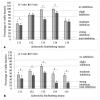Exposing Salmonella Senftenberg and Escherichia coli Strains Isolated from Poultry Farms to Formaldehyde and Lingonberry Extract at Low Concentrations
- PMID: 37834022
- PMCID: PMC10572950
- DOI: 10.3390/ijms241914579
Exposing Salmonella Senftenberg and Escherichia coli Strains Isolated from Poultry Farms to Formaldehyde and Lingonberry Extract at Low Concentrations
Abstract
European Union (EU) countries strive to improve the quality and safety of food of animal origin. Food production depends on a good microbiological quality of fodder. However, feed can be a reservoir or vector of pathogenic microorganisms, including Salmonella or Escherichia coli bacteria. Salmonella spp. and E. coli are the two most important food-borne pathogens of public health concern. Contamination with these pathogens, mainly in the poultry sector, can lead to serious food-borne diseases. Both microorganisms can form biofilms on abiotic and biotic surfaces. The cells that form biofilms are less sensitive to disinfectants, which in turn makes it difficult to eliminate them from various surfaces. Because the usage of formaldehyde in animal feed is prohibited in European countries, the replacement of this antibacterial with natural plant products seems very promising. This study aimed to assess the inhibitory effectiveness of Vaccinium vitis-idaea extract against biofilm produced by model Salmonella enterica and E. coli strains. We found that formaldehyde could effectively kill both species of bacterial cells in biofilm, while the lingonberry extract showed some antibiofilm effect on S. enterica serovar Senftenberg. In conclusion, finding natural plant products that are effective against biofilms formed by Gram-negative bacteria is still challenging.
Keywords: Escherichia coli; Salmonella sv. Senftenberg; Vaccinium vitis-idaea; biofilm eradication; formaldehyde; inhibition.
Conflict of interest statement
The authors declare no conflict of interest.
Figures




Similar articles
-
Lingonberry (Vaccinium vitis-idaea) and European cranberry (Vaccinium microcarpon) proanthocyanidins: isolation, identification, and bioactivities.J Agric Food Chem. 2011 Apr 13;59(7):3373-84. doi: 10.1021/jf104621e. Epub 2011 Mar 3. J Agric Food Chem. 2011. PMID: 21370878
-
The Antibiofilm Effect of Ginkgo biloba Extract Against Salmonella and Listeria Isolates from Poultry.Foodborne Pathog Dis. 2016 May;13(5):229-38. doi: 10.1089/fpd.2015.2072. Epub 2016 Mar 8. Foodborne Pathog Dis. 2016. PMID: 26954614
-
Epizootiologic role of feeds in the epidemiology of Salmonella Senftenberg contamination in commercial layer farms in eastern Japan.Avian Dis. 2012 Sep;56(3):516-20. doi: 10.1637/9964-101611-Reg.1. Avian Dis. 2012. PMID: 23050468
-
Biofilm formation by Salmonella sp. in the poultry industry: Detection, control and eradication strategies.Food Res Int. 2019 May;119:530-540. doi: 10.1016/j.foodres.2017.11.024. Epub 2017 Nov 21. Food Res Int. 2019. PMID: 30884686 Review.
-
Lingonberry (Vaccinium vitis-idaea L.) Fruit as a Source of Bioactive Compounds with Health-Promoting Effects-A Review.Int J Mol Sci. 2021 May 12;22(10):5126. doi: 10.3390/ijms22105126. Int J Mol Sci. 2021. PMID: 34066191 Free PMC article. Review.
References
MeSH terms
Substances
Supplementary concepts
Grants and funding
LinkOut - more resources
Full Text Sources
Miscellaneous

